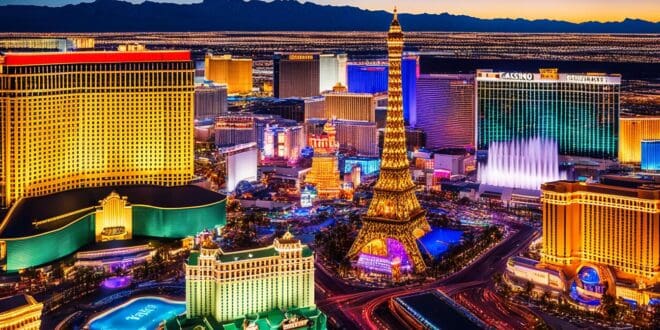The transformation of Las Vegas from a parched desert outpost to a shimmering casino empire is a story of ambition, vision, and relentless evolution. The history of Las Vegas is not just about its neon-lit present; it’s a journey that traces back to its founding in 1905, a strategic point along the railroad between Los Angeles and Salt Lake City. This seminal connection set the stage for a series of turning points which propelled its growth into one of the world’s most famous destinations for gaming and entertainment.
Sparked by the construction of the monumental Boulder Dam, now known as Hoover Dam, the city witnessed a significant surge in its population and the birth of entertainment venues designed to cater to the influx of workers. As the desert sands gave way to electricity and concrete, hotels began to rise along the future Strip, powered by the dam’s promise of boundless energy. Then, as the city evolved, it entered a new chapter when entrepreneur Howard Hughes stepped onto the scene in 1966, initiating a transformation from mob-run town to a family-friendly retreat, complete with the splendor of Mega resorts, forever altering the Las Vegas evolution.
In the midst of recounting this history, it is sobering to remember that the name Las Vegas, Spanish for “the meadows,” was inspired by the green patches discovered in 1829 by the Spanish trader Rafael Rivera. These patches stood out like emeralds amidst the arid expanse while trekking on the Old Spanish Trail, presaging the oasis of opulence that Las Vegas would become.
The Enigmatic Origins of Las Vegas

Long before the bustling streets and neon lights of modern Las Vegas, the valley bore witness to a rich tapestry of history, stretching back to times when prehistoric wildlife roamed a vastly different landscape. Delving into Las Vegas origins, one encounters a prehistoric Las Vegas that was once a fertile marshland teeming with life, providing a stark contrast to the desert city we see today.
- Prehistoric Las Vegas: The valley we now know as Las Vegas was fertile ground for a diverse ecosystem, where Late Pleistocene megafauna such as the Columbian mammoth thrived.
- Paiute History: Evidence such as petroglyphs and recovered artifacts reveal that the Southern Paiute people settled in the valley over 10,000 years ago, establishing a profound connection with the land that continues to resonate in their cultural heritage.
- Spanish Explorers: Entering the annals of recorded history, the journey of Spanish explorers brought European eyes to the valley. It was during an 1829 expedition they witnessed the oasis in the desert, which later became known as Las Vegas.
- Antonio Armijo: The figure of Antonio Armijo stands pivotal in this historical narrative, for his expedition carved a path through the valley, laying foundational stones for the city’s European-linked beginnings.
The juxtaposition of prehistoric habitats with the footprints of Paiute people and the march of Spanish explorers like Antonio Armijo encapsulates a multifaceted origin story of Las Vegas. This mosaic of early beginnings, each layer adding depth and dimension, contributed to the complex tale of how a desert marshland evolved into a world-renowned city.
- The valley’s ecological richness created a hospitable environment for flora and fauna long before human influence.
- Indigenous Paiute tribes lived in harmony with their surroundings, leaving behind a legacy etched in stone and woven into the fabric of their baskets.
- The arrival of Spanish explorers such as Antonio Armijo signaled a new chapter in the valley’s transformation, one that would eventually give rise to the iconic Las Vegas.
The Emergence of a Desert Oasis: Early Settlements
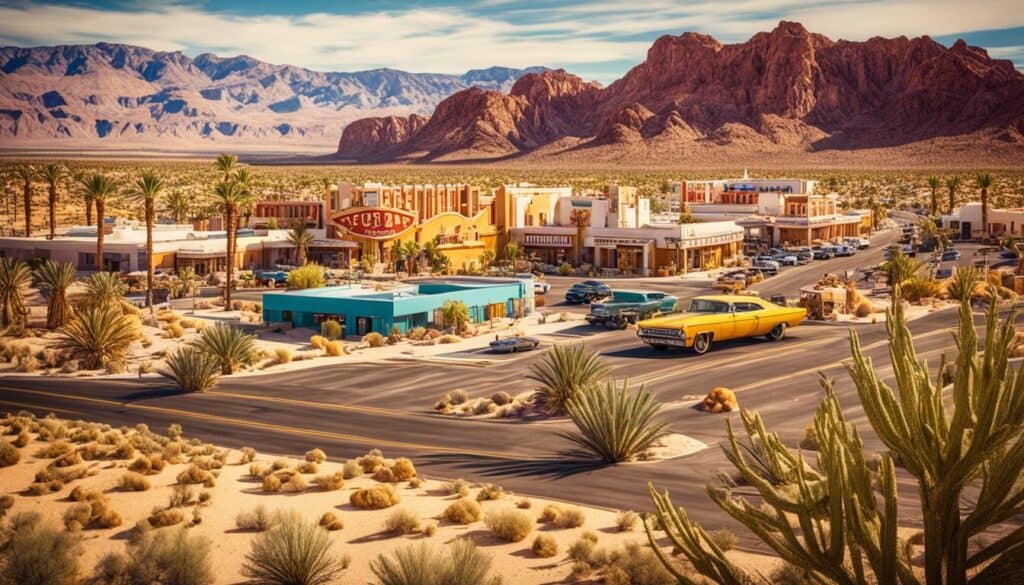
The swathes of desert that now cradle the gleaming city of Las Vegas were once silent witnesses to the early chapters of its storied past. It was the spirit of Spanish exploration and the pursuit of new routes that brought the first European eyes to behold what would become a bustling oasis.
Spanish Exploration and Naming the Valley
The Las Vegas Valley owes its discovery to the intrepid Spanish traders journeying along the Old Spanish Trail. Amidst these early explorers was Rafael Rivera, whose foray into the area unveiled the presence of lush meadows, fed by artesian wells. The pristine beauty of these verdant patches amid the arid landscape earned the valley its name, “Las Vegas,” under Rivera’s Spanish exploration in 1829, marking a pivotal moment in the Las Vegas founding narrative.
Mormon Influence and the Abandoned Fort
The narrative of Las Vegas’ early years intertwines with the tale of Mormon settlers. In the mid-19th century, a group of industrious members of The Church of Jesus Christ of Latter-day Saints sought to expand their settlement westward. They erected a fort in 1855, engaging in rigorous agrarian efforts to tame the harsh desert terrain. The venture proved unsustainable, and the fort was ultimately vacated, leaving behind a structure that would soon be repurposed for a different destiny.
Octavius Gass and the Las Vegas Rancho
It was entrepreneur Octavius Gass who recognized the potential of the abandoned fort and surrounding fertile land, thus breathing new life into the forsaken structure. Gass established the Las Vegas Rancho, invigorating it as a central fixture on the Old Spanish Trail. His transformation of the site not only harnessed the previous efforts of the Mormon settlers but also carved out an agricultural haven that would continue to play a role in the narrative of the region.
History of Las Vegas: Railways and Real Estate

The transformative power of infrastructure on early Las Vegas development cannot be overstated; at the heart of this change lay the sprawling tracks of the San Pedro, Los Angeles & Salt Lake Railroad. The year 1905 marked a radical departure from obscurity for Las Vegas thanks to this crucial development. As steel rails connected distant cities and transformed the social and economic landscape of Clark County, it was a time of burgeoning optimism and untapped potential, driven by the latent promise of a modern city rising from the desert floor.
Influential pioneers, such as William Clark, with their forward-thinking vision, played key roles in the railroad’s expansion, understanding that connectivity was tantamount to growth. Clark, a senator and business magnate, recognized the importance of reliable transportation to foster trade and attract settlers; his efforts were pivotal for not just Las Vegas but the entire region that would soon bear his name.
- Crucial railroad completion spurring Las Vegas’s formal establishment
- Significant economic stimulus from improved connectivity promoting settlement
- The role of the San Pedro, Los Angeles & Salt Lake Railroad in Clark County’s founding
The tracks laid across Nevada-swept terrain heralded the inception of what we now extol as Clark County, a testament to the indelible imprint of pioneers on the Las Vegas railway history. These iron pathways did more than enable locomotives’ passage; they redefined the destiny of a region, transforming it from an arid expanse into a flourishing residential and commercial hub.
Acknowledging the synergy between transportation and urbanization, the railway’s influence on the landscape facilitated real estate developments and propelled the embryonic town on a trajectory towards becoming a nerve center of activity. The depot, Las Vegas’ heart during those nascent years, cemented the city’s future as a linchpin of trade and social interaction. As the ribbons of rails unfurled across the valley, they laid the groundwork for decades of prosperity, enabling the early Las Vegas development to transition seamlessly into a modern era.
Today, as we traverse the bustling streets of Las Vegas and marvel at its audacious skyline, it is with a nod to the audacious spirit of those who gambled on the potential of a modest railroad town. They bequeathed a legacy of growth and opportunity that continues to bear fruit in the vibrant life found in Clark County, where once there was silken quiet and shifting sands.
The Prohibition Period and Secretive Casino Beginnings
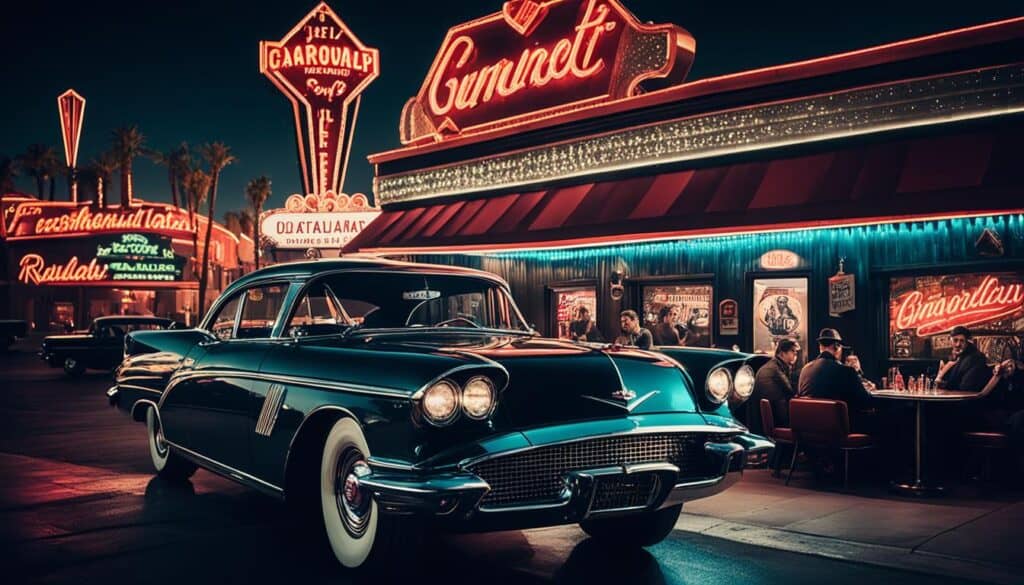
The 1910s ushered in a transformative era for Las Vegas, characterized by the Las Vegas prohibition era measures that sought to extinguish the flames of gambling. Yet, as history attests, the indomitable spirit of Las Vegas would not be so easily quelled.
Outlawing of Gambling in 1910
Legislation may have formally prohibited gambling activities, but the resilience of local gaming enthusiasts ensured that secret casinos continued to operate, skirting the edges of legality. This clash between law and practice laid the groundwork for the city’s infamous dive into nightlife and entertainment, driven by a need to satisfy the unyielding demand for games of chance.
The Speakeasy Undercurrent
Despite the heavy hand of prohibition, Las Vegas evolved below the radar, cultivating a burgeoning network of speakeasies. These establishments didn’t just serve as watering holes but became covert temples to the vice of gambling, seeding the eventual rebirth of the gaming industry. This speakeasy undercurrent was a testament to the enduring allure of the forbidden, setting the stage for the Las Vegas evolution into the world’s gaming epicenter.
- An eternal game of cat and mouse with law enforcement
- The cultural impact of speakeasies on Las Vegas society
- The clandestine progression from speakeasies to landmark casinos
It was in the veil of secrecy and the whispers of rebellion where modern-day Las Vegas found its true calling. From these prohibition-era roots would grow an empire of leisure and luck that continues to captivate the imagination of the world. At the heart of this change was not just the desire to gamble but the fundamental human yearning for excitement and novelty that Las Vegas would come to symbolize.
Hoover Dam: Turning the Tide for Las Vegas

The narrative of Las Vegas is inexorably linked to the monumental Hoover Dam construction, a feat that crucially spurred the city’s development. The endeavor not only represented an engineering marvel but also acted as a catalyst for unprecedented Las Vegas population growth. Workers drawn by the promise of employment settled in the area, engendering a surge in local infrastructure and housing.
This demographic upsurge begat a need for entertainment and leisure, effectively birthing the city’s legendary casino entertainment industry. To accommodate the growing populace, the Las Vegas landscape swiftly transformed, with establishments ranging from gaming houses to showgirl venues cropping up, thus irrevocably transforming the city into an epicenter for ceaseless amusement.
- The inauguration of the Hoover Dam set off a population explosion.
- Employment opportunities elevated Las Vegas’s profile on the national stage.
- Expansion of the casino entertainment industry in response to a booming workforce.
- Las Vegas metamorphosed into a round-the-clock bastion of leisure and extravagance.
Today, the legacy of the Hoover Dam extends beyond its architectural grandeur. It represents a historical pivot point for Las Vegas, an event that shaped it into a destination synonymous with bright lights, endless entertainment, and the thrum of the casino floors — all beacons drawing in millions of visitors annually to the desert now aglitter with possibility.
The Golden Era: Bugsy Siegel and the Flamingo
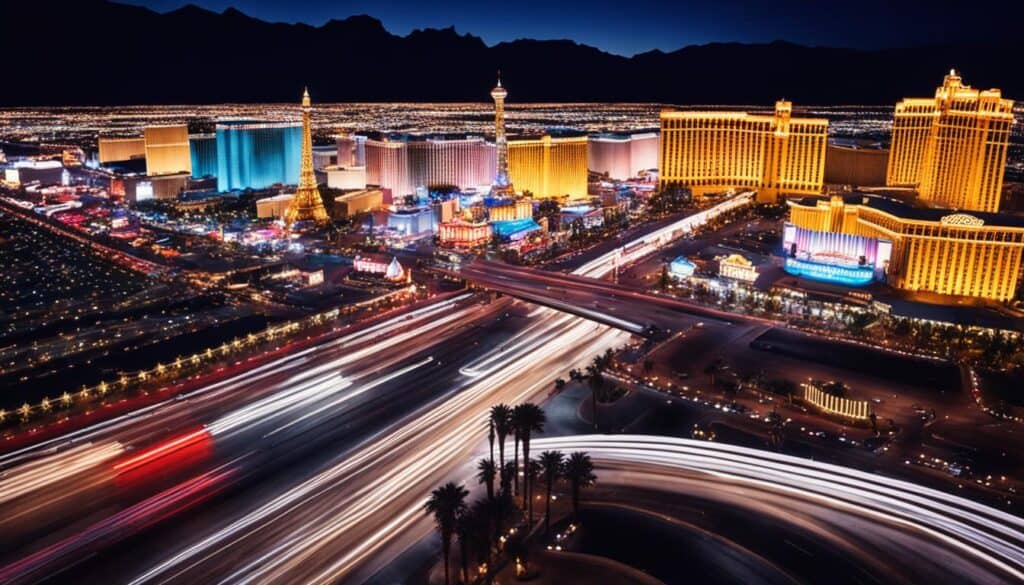
Drenched in the allure of sophistication and secrecy, the Golden Era of Las Vegas remains an epoch highlighted by fast-rising casinos, notorious mob figures, and the shimmering desert becoming a beacon for high stakes and higher society. At the heart of this transformation was the enigmatic Bugsy Siegel, whose dream to create an oasis of luxury in the midst of the arid Mojave culminated in the establishment of the Flamingo Hotel. With its ties to organized crime and its role as a glamorous retreat, the Flamingo became an integral cornerstone of Las Vegas history.
Iconic Vegas Milestones and Mob Influence
The mob’s shadow over Las Vegas during the mid-20th century is undeniable, with the city’s rapid growth intertwined with the influence of organized crime. The Flamingo’s opening under Siegel’s guidance stood as a testament to mob involvement in the development of Las Vegas, though it teetered on a precarious edge due to its underground financing. Despite controversy and speculation, this period marked the city’s accelerated ascent to becoming the world’s gaming capital.
The Celebrity Magnet of Early Las Vegas
Inextricable from the story of the Flamingo and Bugsy Siegel was the glittering allure that turned Las Vegas into a siren call for the elite. The Flamingo, with its plush accommodations, top-tier entertainment, and promise of discretion, became a celebrated destination for movie stars, musicians, and the social glitterati. A celebrity hotspot, its exclusive allure was fundamental in cementing Las Vegas’ standing as not just a gambling hub, but also a mainstay of opulent leisure and spectacle, projecting an image of unattainable luxury that defined an era.
Revolutionizing Entertainment: The Rise of Showgirls and Casinos
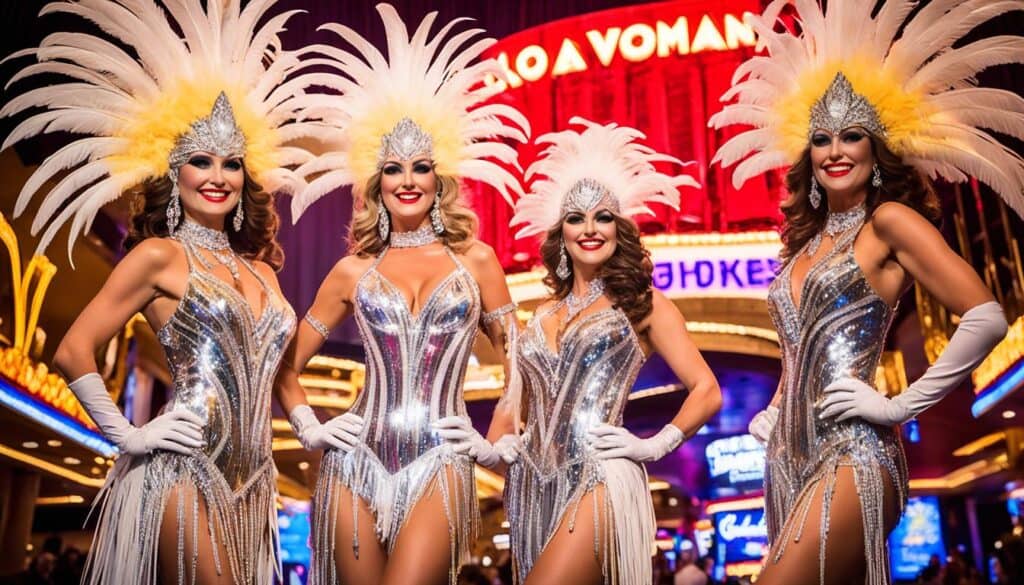
The entertainment landscape in Las Vegas witnessed an unprecedented transformation with the advent of showgirls and casinos, marking an entertainment revolution. This fusion of high-energy dance performances with the mesmerizing allure of the casino gaming floor created a new paradigm for the industry and solidified Las Vegas as the ultimate destination for adult entertainment.
The Las Vegas showgirls, with their opulent feathered costumes and sophisticated dance routines, became emblematic of the city’s lavish productions. These performances garnered worldwide attention and contributed significantly to the evolution of entertainment in the city:
- The integration of stage spectaculars with the gaming environment introduced a holistic entertainment experience that was unique to Las Vegas.
- Iconic shows and revues became a staple, running concurrently with the vibrant sounds of slot machines and buzz of the craps tables.
- Showgirls embodied an era of glamour, complementing the high-stakes and luxury associated with the burgeoning casino industry.
Simultaneously, the evolution of the casino industry in Las Vegas was making giant strides. The rapid expansion and development of casinos were not merely about gaming; they entailed an entire ecosystem of leisure and spectacle:
- Casinos began offering more than just games; they created an atmosphere of non-stop thrill with amenities like upscale restaurants, shopping, and live concerts.
- The design and themes of various casinos played a significant role in offering visitors a unique and immersive experience, from the opulence of Ancient Rome to the mysteries of Egypt.
- Investments soared as both domestic and international financiers sought to carve out their corner on the Strip, each new property trying to outdo the last in terms of luxury and grandeur.
This period laid the foundation for what would become a deeply intertwined relationship between performance art and gaming, further entrenching Las Vegas’ position as a pioneering force in the global entertainment industry.
The Transformation of Las Vegas in the Atomic Age

The 1950s ushered in an era of unprecedented change in Las Vegas, as the city found itself at the crossroads of post-war optimism and the burgeoning Atomic Age. As the Nevada Test Site commenced operations, Las Vegas transformed from a rising desert getaway into a surreal spectacle where atomic bombs and entertainment culture collided with uniquely American exuberance.
The Nevada Test Site and its Unexpected Tourist Draw
Just 65 miles northwest of the Las Vegas Strip, the Nevada Test Site became an unexpected catalyst for tourism. The promise of witnessing an atomic blast drew thousands to Las Vegas, turning the eerie glow of nuclear detonations into a bizarre tourist attraction. Hotels capitalized on this phenomenon, offering “atomic cocktails” and “dawn bomb parties,” where guests could watch the blasts from rooftops. The Atomic Age had an indelible impact on Las Vegas, weaving nuclear energy into the very fabric of its identity and lore.
Neon Lights and Nuclear Explosions: The Unique Cocktail of 50s Vegas
The conjunction of neon lights with the atomic blasts created a bizarre duality that defined the era. Las Vegas became synonymous with both the glitz of casino neon and the awe-inspiring power of the atom. This fusion led to a culture where one could gamble under the dazzling neon lights and then observe a mushroom cloud rising in the distance, an experience unique to the Atomic Age and 1950s Vegas culture.
While the Nevada Test Site brought an air of modernity and scientific progress, the city continued to flourish under the vibrant glow of neon signs. The iconic “Welcome to Fabulous Las Vegas” sign and other neon fixtures rose as beacons, cementing the city’s reputation as a luminary oasis of nighttime entertainment and establishing a visitor experience like no other on the globe.
The Atomic Age’s impact on the city extended beyond tourism and culture—its influence penetrated the local psyche and aesthetic, embedding itself into Vegas’ very spirit. This period of explosive growth and illumination not only shaped Las Vegas’ skyline but also its enduring allure as a city of spectacle, wonder, and boundless possibility.
The Corporate Takeover: From Mob to Hoteliers
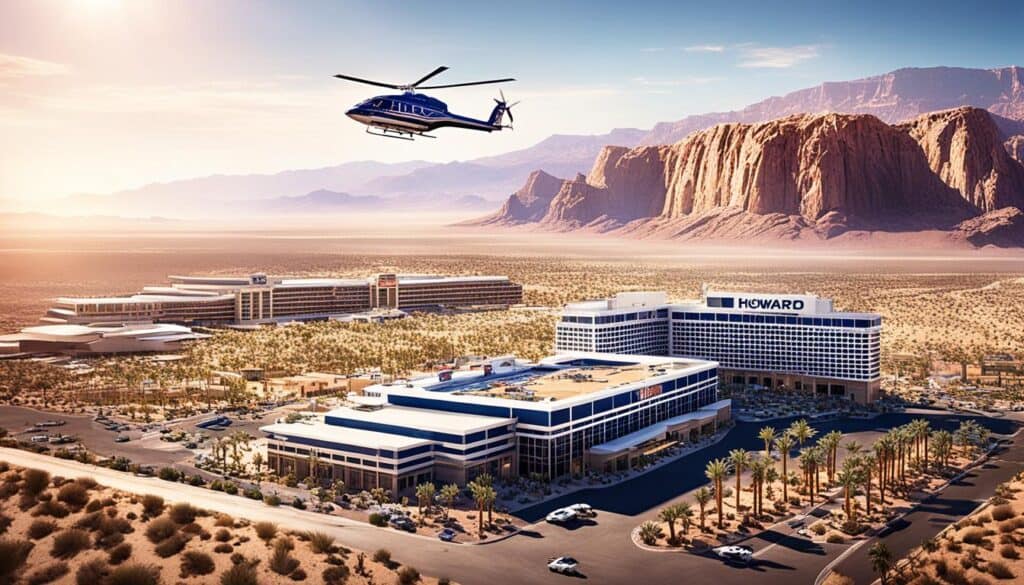
The dawn of a new era in Las Vegas history was heralded by the aviation magnate and film director Howard Hughes in the late 1960s. His influence marked a significant turning point, redefining the cityscape from one controlled by organized crime to a landscape dominated by corporate entities. The Las Vegas corporate takeover is a remarkable chapter in the historical transformation of Las Vegas, a period where power shifted and the skyline began to take the form we recognize today.
Let’s delve into the specifics:
- Famed recluse Howard Hughes began his quiet invasion of the strip by purchasing the Desert Inn, after being asked to vacate his penthouse suite. This was just the beginning of what would become a legendary investment spree.
- Howard Hughes’ investments did not stop there. His empire quickly expanded with additional acquisitions such as the Sands, Castaways, Frontier, Silver Slipper, and the Landmark. Each acquisition reinforced the sentiment of a changing guard over Sin City’s enterprises.
- With the buy-out of multiple establishments previously run by mob figures, his actions signalled to the world that the era of the Las Vegas corporate takeover had definitively begun. Business moguls and reputable corporations began to replace the reputedly notorious figureheads of the gambling world.
- The corporate climate fostered by Hughes paved the way for further institutional investments by other notable corporations, including mega-resorts backed by globally recognized brands.
- This influx of legitimate investment helped in restructuring the city’s image, leading to a family-friendly reputation that befits the global tourist destination Las Vegas is known as today.
In essence, the investments made by Howard Hughes served as a catalyst, galvanizing the city’s evolution from its mobster-run past into the corporate-fuelled entertainment capital of the world.
Las Vegas and the Evolution of Gaming Technology
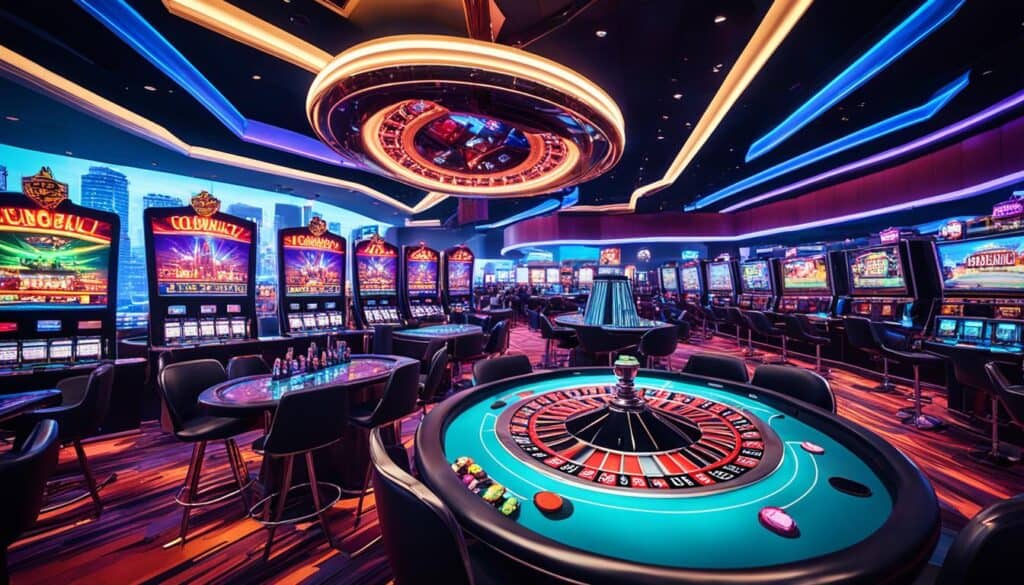
The allure of Las Vegas has always been its ability to blend the thrill of gaming with the ceaseless march of technological progress. The famed city’s commitment to innovation has established its reputation as a trailblazer in the casino industry, continually adopting and fostering the evolution of gaming technology in Vegas.
The Introduction of Video Slot Machines
At the heart of Las Vegas’ transformation was the introduction of video slot machines. These sophisticated devices revolutionized traditional slot play, offering a dazzling array of graphics, themes, and gameplay features that enraptured players. Not only did they extend the gaming floor’s energy, but video slot machines also became a defining feature of Las Vegas’ evolution into a digital gaming empire.
The Advent of Online Casinos and Modern Gaming Innovations
As technology advanced, Las Vegas didn’t just keep pace—it set the precedent. The rise of online casinos marked a monumental leap forward, allowing the excitement of Vegas gaming to reach a global audience. These platforms introduced a new era of convenience and accessibility in the industry, further propelled by gaming innovations like virtual reality and blockchain that are currently reshaping the gaming landscape.
- Gaming Software Development: Pioneering interactive and immersive game designs.
- Mobile Gaming Expansion: Capitalizing on the ubiquity of smartphones to deliver gaming on the go.
- Live Dealer Integration: Bridging the virtual realm with the authenticity of live casino play.
Vegas continues to be synonymous with cutting-edge gaming experiences, ensuring visitors and online patrons alike receive nothing less than the golden standard of entertainment the city is known for.
Historic Las Vegas Casino Heists: A Lesson in Security

The glittering casinos of Las Vegas have not just been stages for high-stakes gambling and opulent shows; they have also played host to some of the most audacious heists in history. The tales of these historic Las Vegas casino heists are not merely anecdotes of criminal ingenuity, but rather, critical chapters that have informed and redefined Las Vegas security measures. In response to these events, the city’s iconic establishments have evolved, adopting a fortress mentality with an arsenal of surveillance and security strategies to ensure the safety of their patrons and the integrity of their operations.
- Stardust Skim: Perhaps one of the most renowned incidents saw the stealthy extraction of millions of dollars over decades from the Stardust and other casinos, which went undetected due to the ingenious methods of the perpetrators.
- Circus Circus Heist: Another known heist involved a highly orchestrated robbery at Circus Circus, in which the assailants managed to escape with a significant sum, putting a spotlight on the need for improved cash handling protocols.
- Bellagio Bandit: The Bellagio Bandit’s brazen motorcycle getaway after pocketing chips underscored the necessity for more refined suspect apprehension methods and chip tracking technologies.
In the wake of such breaches, Las Vegas casinos have escalated their security measures to levels comparable to that of financial institutions. Advanced technologies such as high-resolution surveillance cameras, facial recognition systems, RFID chip tracking, and robust cyber security frameworks are now staples in the landscape of casino security, setting a gold standard internationally.
The implementation of these Las Vegas security measures has done more than just protect assets; it has reassured the millions of visitors who flock to the city for unrivaled entertainment experiences that their safety is taken with the utmost seriousness. Thus, the historic Las Vegas casino heists remain an indelible part of Sin City’s narrative, serving as a catalyst for the evolution of security measures that uphold its reputation as the ultimate adult playground, safe from the reach of modern-day desperados.
From Glitz to Glamour: The Transformation of The Strip
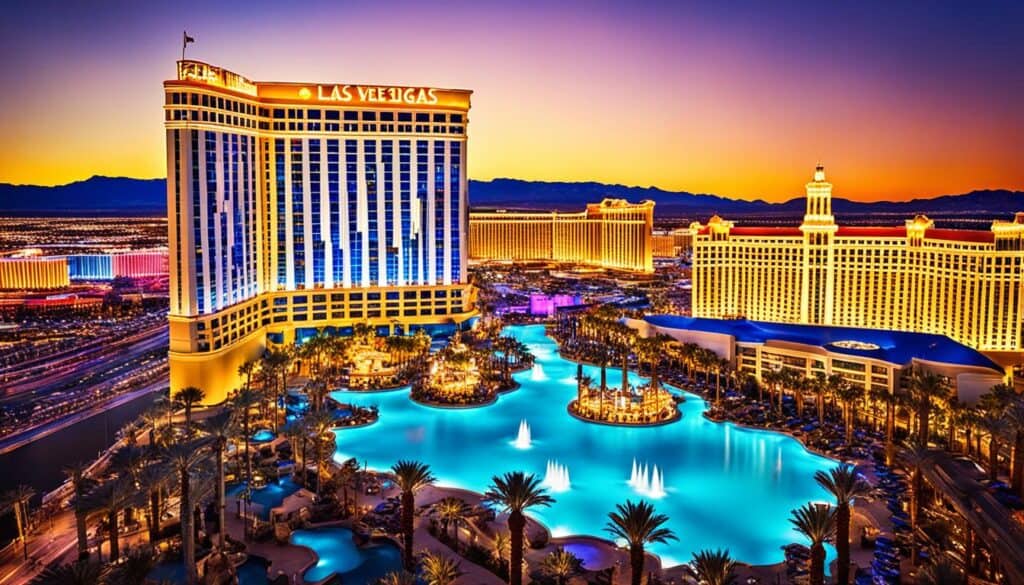
The iconic Las Vegas Strip, once known for its dazzling neon lights and high-stakes casinos, has evolved into a collection of architectural wonders and entertainment destinations. The Strip transformation has been characterized by the rise of Las Vegas mega-resorts that offer a blend of luxurious accommodations, fine dining, and unrivaled entertainment options. These developments have reshaped the city’s skyline and redefined the visitor experience, positioning Las Vegas not just as a gambling haven but as one of the world’s premier entertainment meccas.
The Development of Mega-Resorts
Notable developments in the Las Vegas Strip have seen the construction of massive complexes where guests can find everything they need under one roof. These Las Vegas mega-resorts often span several acres, with luxurious amenities including themed shopping arcades, expansive pool complexes, and state-of-the-art convention spaces. They are designed to captivate and keep guests entertained throughout the duration of their stay, with every element meticulously crafted to ensure an unparalleled experience.
Today’s Themed Hotel-Casinos and Entertainment Meccas
The themed hotel-casinos of Las Vegas are a testament to the city’s imaginative spirit. Drawing inspiration from destinations around the globe, visitors can traverse from the romantic canals of Venice to the bustling streets of New York City within a matter of blocks. These themed establishments are not just about gaming; they offer a cornucopia of entertainment options, including Broadway-caliber shows, A-list music residencies, and attractions for all ages, solidifying The Strip’s reputation as a versatile entertainment mecca.
- Experience the enchanting ambiance of the Bellagio’s dancing fountains and Conservatory & Botanical Gardens
- Step into Caesar’s Palace and roam through an empire brimming with culinary delights and epic shopping experiences
- Embark on a gondola ride at The Venetian, where the essence of Italy is captured amidst the excitement of Las Vegas
- Marvel at the colossal Luxor pyramid, offering a touch of ancient Egypt in the heart of The Strip
Las Vegas Today: A Symphony of Lights and Leisure

Immerse yourself in the vibrancy and excitement of contemporary Las Vegas, a city that ignites the imagination with its spectacular displays and world-class entertainment. The transformation of Las Vegas into a global cultural touchstone has been nothing short of phenomenal, with an aura of leisure and liveliness that envelopes every visitor.
Renowned for its breathtaking performances that merge artistry with the surreal, Cirque du Soleil has redefined the essence of Vegas shows, contributing significantly to the city’s cultural landscape. The blend of acrobatics, storytelling, music, and visual effects creates an unrivaled spectacle that continues to draw audiences from around the globe.
The Impact of Cirque du Soleil and Residency Shows
Residency shows are the bedrock of Las Vegas entertainment, with top-tier artists establishing their presence in the heart of the desert. These engagements guarantee visitors a chance to witness their favorite performers in an intimate setting, transforming the city into a perennially bustling center of the music industry.
- Unforgettable shows by legends who make Vegas their temporary home
- Custom-built theaters offering an immersive viewing experience
- A fusion of glamour and artistic expression that captivates all senses
Las Vegas’ residency shows serve as an enduring tribute to its capacity for reinvention and a testament to its appeal as an entertainment mecca.
Las Vegas as a Global Cultural Phenomenon
The cultural impact of Las Vegas stretches far beyond its borders, influencing the entertainment landscape worldwide. It synthesizes the audacious spirit of the city with the diversity of performances and events that call it home, setting new standards for luxury and spectacle on an international scale.
- Its influence on popular culture is evident in film, music, and television.
- Las Vegas continues to shape global trends in hospitality and gaming.
- The city’s evolution into a renowned destination underscores its global cultural impact.
As Las Vegas continually evolves, it champions innovation, leaping forward in the realms of entertainment and cultural significance.
The History of Las Vegas: From Roots to Riches
The Las Vegas historical journey is as dazzling and storied as the neon lights that illuminate its skyline. From its desert origin to wealth, this city has undergone an astonishing metamorphosis, evolving into an emblem of luxury and the epitome of the American dream. What was once an unforgiving desert landscape has blossomed into a vibrant metropolis, bursting with life and opportunity. Las Vegas stands as a testament to human ingenuity and the allure of possibility, drawing millions to experience its unique brand of excitement.
Laying the foundation for what would become a legendary city, early explorers and settlers saw potential in the valley’s artesian wells and natural resources. Fast forward through rapid railroad expansions, the construction of the iconic Hoover Dam, and the city’s pivotal role in entertainment history, Las Vegas has crafted a transformative legacy unlike any other. With each passing decade, the city has seamlessly navigated the tides of change, incorporating new technologies and trends, always staying a step ahead in the hospitality and gaming industry.
Today, Las Vegas’s success is visible in its towering mega-resorts, bustling casino floors, and the mesmerizing entertainment on offer. This city, thriving amidst the Mojave Desert, continues to evolve, building upon its rich legacy with every jackpot won and every marquee lit. It is this unceasing reinvention and resilience that cements Las Vegas as a global standard for leisure and a beacon of progress. It is more than just a city; it is a reflection of ambition, an enduring symbol of growth from modest beginnings to spectacular heights – truly, a transformative journey from roots to riches.
 Online Gaming Circuit
Online Gaming Circuit
